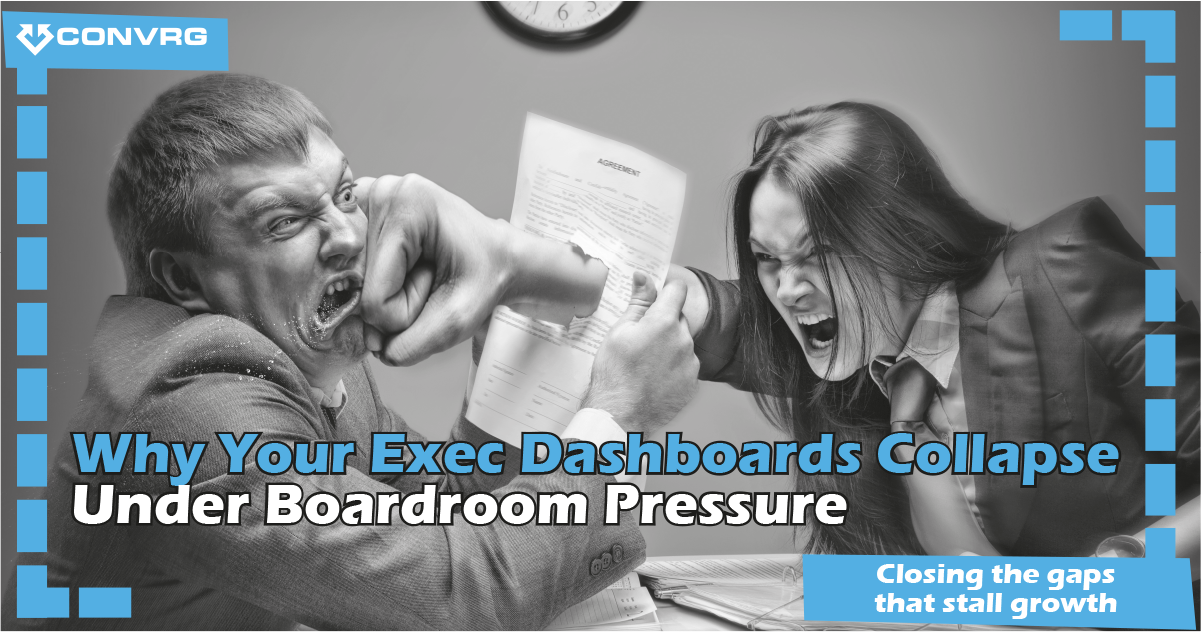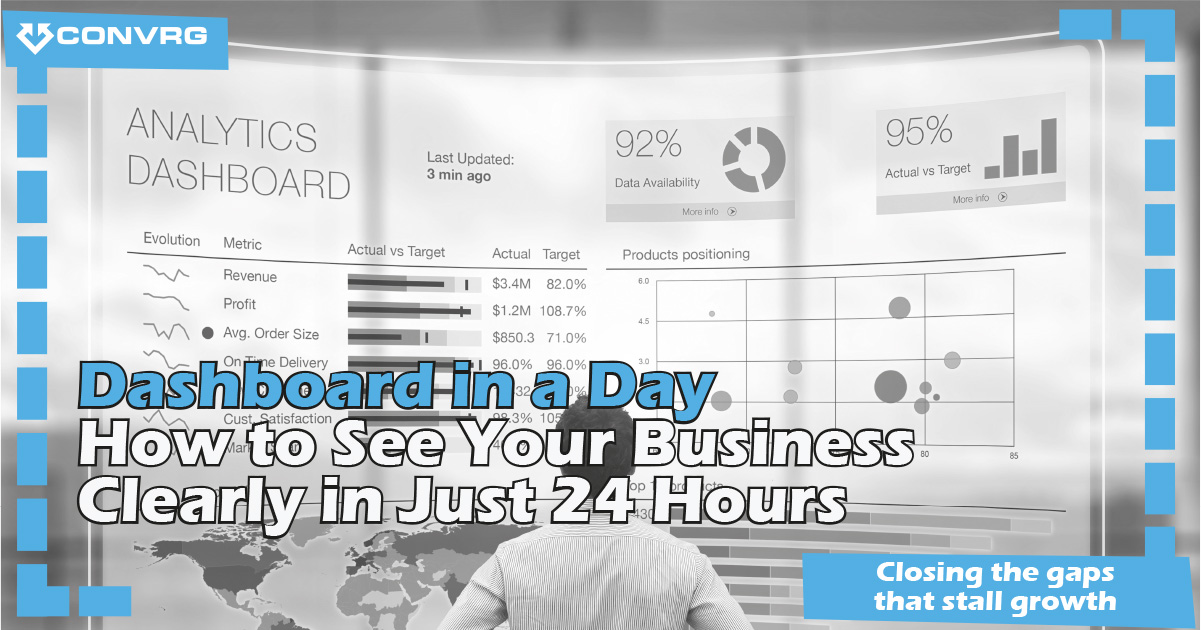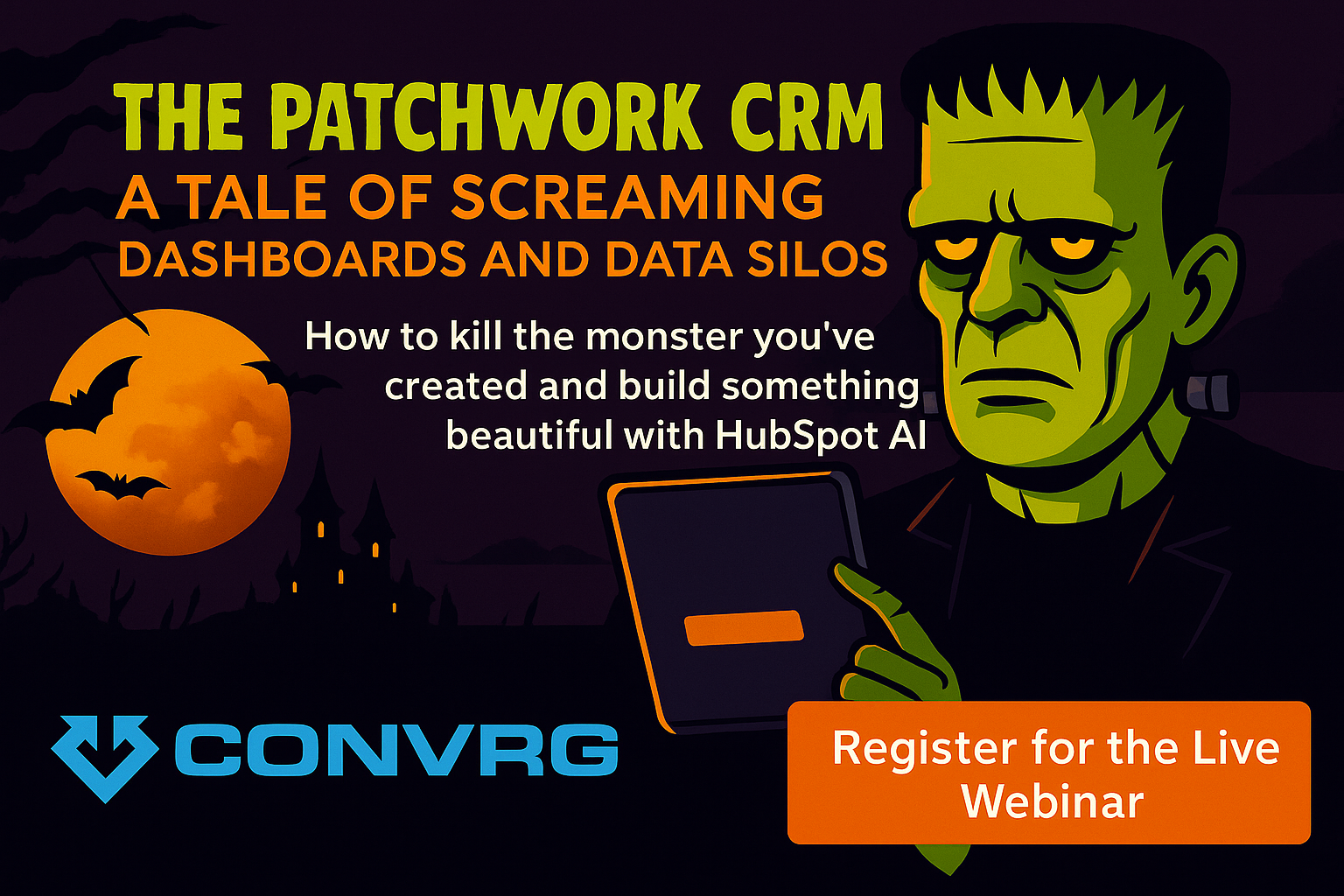The Moment It Breaks
It’s Thursday morning. The boardroom feels like a pressure cooker.
Your HubSpot exec dashboard is up on the big screen - sleek, colourful, reassuring.
You’ve rehearsed this. Pipeline’s strong. Marketing’s smashed MQL targets. Forecasts are confident.
You take a breath and start.
“Revenue’s on track. Pipeline’s healthy. We’re ahead of plan.”
The CEO nods. The CFO glances at the numbers. You feel that flicker of relief.
Then the Chair leans forward.
“If this forecast is right, why did we miss target last quarter?”
Silence.
The CFO speaks: “Finance numbers don’t match these.”
Sales adds: “Half those deals are stuck.”
Marketing fires back: “Our leads are qualified. Sales isn’t converting.”
Suddenly, your dashboard - your shield - has become the weapon.
We see this every week at CONVRG.
Leadership dashboards collapse the moment they’re scrutinised because they’re built for presentation, not decisions.
And when they fail, you take the hit.
Dashboards Built to Impress, Not Inform
Exec dashboards are supposed to protect you in moments like this.
They should make board conversations easier, not harder.
But most dashboards we audit aren’t designed for leadership. They’re built for storytelling - colourful charts, vanity metrics, and feel-good KPIs - not for scrutiny.
The Bottom-Up Trap
Here’s the trap most businesses fall into:
- Marketing builds dashboards to showcase volume.
- Sales builds dashboards to track quota.
- Ops builds dashboards to measure compliance.
- Finance… builds something completely separate.
Each team designs for itself. Nobody designs for leadership.
The result?
- Marketing says it’s smashing targets.
- Sales says leads are unworkable.
- Finance questions both.
One dashboard. Three stories. Zero alignment.
The Illusion of “One Source of Truth”
HubSpot sells the promise of a single source of truth.
But without:
- Shared definitions,
- Aligned lifecycle stages,
- And consistent data discipline,
…your dashboards aren’t one truth. They’re three competing realities dressed in matching colours.
Case Study: Frontier Medical
When Frontier Medical came to us, they thought dashboards were the one thing that didn’t need fixing.
Marketing reported record-breaking MQLs.
Sales claimed pipeline was booming.
Leadership presented the dashboards to the board with confidence.
But forecasts were consistently wrong.
When the CFO asked,
“If pipeline’s this strong, why does finance disagree?”
…everything unravelled.
Our audit uncovered:
- 40% of MQLs were duplicates.
- Pipeline value was overstated by £1.2m.
- Lifecycle stages weren’t aligned between teams.
- Forecasts were missing reality by 50%+.
We rebuilt Frontier’s dashboards from the top down:
- Defined shared KPIs across marketing, sales, and ops.
- Focused dashboards on conversion health, not vanity metrics.
- Delivered a leadership-ready reporting layer tied to business outcomes.
Within six weeks:
- Forecast accuracy improved by 94%.
- Board confidence was restored.
- Leadership regained control.
The Hidden Leadership Cost
Bad dashboards aren’t just a reporting issue - they’re a credibility issue.
Strategic Misfires
- You double down on “high-performing” channels that don’t drive revenue.
- You over hire based on inflated forecasts.
- You miss early churn signals that could’ve saved customers.
Boardroom Distrust
Boards expect precision.
When dashboards contradict finance reports:
- The CFO loses faith in leadership.
- Investors question your operating model.
- Funding rounds get harder.
The Adoption Spiral
Once execs stop trusting dashboards:
- Sales stops updating deals.
- Marketing stops enriching contacts.
- Ops loses visibility into performance.
Soon, HubSpot isn’t driving growth - it’s holding you back.
Case Study: Myenergi
Myenergi scaled into multiple regions at speed.
Each tracked metrics differently. Dashboards fragmented. Leadership couldn’t compare performance globally.
In one Dashboard in a Day session, we:
- Standardised reporting definitions across regions.
- Built exec dashboards tied directly to KPIs.
- Delivered a single, board-ready view of performance.
With one source of truth, Myenergi accelerated international expansion with confidence.
How Leadership Dashboards Should Work
An exec dashboard isn’t a “prettier report.”
It’s a decision-making instrument.
The right dashboards:
- Highlight the signals leadership needs to act on.
- Hide irrelevant noise.
- Stand up to board-level scrutiny.
Here’s how to build dashboards the board actually believes.
Start With Decisions, Not Data
Dashboards must answer the hard leadership questions first:
- Are we growing profitably?
- Where are deals stalling?
- Are forecasts accurate and defensible?
- Which risks need urgent action?
If a dashboard doesn’t help leadership decide, it doesn’t belong.
One Version of the Truth
Leadership dashboards only work when:
- Lifecycle stages are aligned across every team.
- KPIs are defined once - and agreed by all.
- Finance, sales, and marketing share the same numbers.
Without this, dashboards aren’t insights. They’re data theatre.
Layered Reporting Views
We build dashboards as a reporting hierarchy:
- Exec dashboards → strategic KPIs only.
- Management dashboards → operational levers.
- Team dashboards → activity-level detail.
Exec dashboards stay clean.
Noise lives lower down the stack.
The Dashboard Stress Test
Here’s how to know if your dashboards are board-ready.
Before your next leadership meeting, ask yourself:
- Can I defend every number on this dashboard under scrutiny?
- Do finance, sales, and marketing all agree on these figures?
- Does this dashboard flag risks before they hit the board pack?
- Could I run the business for 90 days on this view alone?
- Would I trust this dashboard with my reputation?
If you said “no” to two or more, your dashboards aren’t ready.
Dashboard in a Day: Clarity in 24 Hours
Boards won’t wait for a six-month reporting rebuild.
That’s why we built Dashboard in a Day.
In just 24 hours, we:
- Audit your HubSpot reporting setup.
- Align leadership on shared definitions.
- Deliver a single, exec-ready dashboard designed to withstand board-level scrutiny.
One dashboard. One language. One version of the truth.
Case Study: Bridgend College
When Bridgend College’s adoption stalled after headcount cuts, dashboards drifted.
Leads weren’t updating. Forecasts failed. Leadership confidence nosedived.
In a single day, we:
- Realigned lifecycle definitions.
- Simplified reporting layers.
- Delivered dashboards leadership could defend.
Next board meeting? Total clarity.
The Bottom Line
Dashboards shouldn’t make you look good.
They should make you bulletproof.
If your exec dashboards collapse under boardroom pressure, HubSpot isn’t broken - your reporting model is.
The fix isn’t a rebuild.
It’s a reset.
[Book Dashboard in a Day]
Build dashboards the board can finally believe in.








.png)
